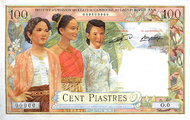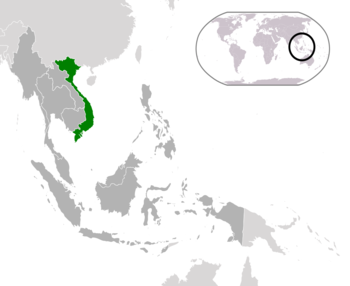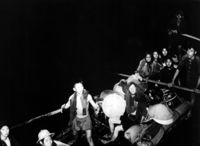دولة ڤيتنام
| ||||||||||||||||||||||||||||||||||||||||||||||||||||||||||||||||||
| ||||||||||||||||||||||||||||||||||||||||||||||||||||||||||||||||||
دولة ڤيتنام (ڤيتنامية: Quốc gia Việt Nam؛ فرنسية: État du Viêt-Nam) كانت دولة ادعت السلطة على كل ڤيتنام أثناء حرب الهند الصينية الأولى بالرغم من أن جزءاً من أراضيها كان بالفعل تسيطر عليه ڤيت منه الشيوعية. الدولة خـُلِقت في 1949 واعتـُرف بها دولياً في 1950. الامبراطور السابق باو داي كان كبير الدولة (Quốc Trưởng). وبعد اتفاقيات جنيڤ 1954، كان على دولة ڤيتنام التخلي عن الجزء الشمالي من البلد لصالح جمهورية ڤيتنام الديمقراطية. وعـُيـِّن نو دين دييم رئيساً للوزراء في نفس العام، وبعد الاطاحة بباو داي في 1955، أصبح رئيس جمهورية ڤيتنام.
التاريخ
توحيد ڤيتنام (1947–48)
منذ ثورة أغسطس، استولت ڤيت منه على كل أراضي ڤيتنام. جمهورية ڤيتنام الديمقراطية أسستها ڤيت منه في 2 سبتمبر, 1945 and the DRV had controlled all of territories of ڤيتنام.
بحلول فبراير 1947، إثر إخضاع تونكين (ڤيتنام الشمالية)، عادت العاصمة التونكينية، هانوي، ومحور المرور الرئيسي تحت السيطرة الفرنسية. الڤيت منه partisans were forced to retreat into the jungle and prepared to pursue the war using حرب عصابات.
لتقليل نفوذ زعيم الڤيت منه هو تشي منه على الشعب الڤيتنامي، دعمت السلطات الفرنسية في الهند الصينية عودة الامبراطور (آخر حكام أسرة وين)، باو داي إلى السلطة بتأسيس دويلات عميلة، منها دولة ڤيتنام. وكان باو داي قد تنازل طوعياً عن العرش[1] في 25 أغسطس 1945، بعد سقوط امبراطورية ڤيتنام قصيرة العمر، دولة عميلة لامبراطورية اليابان.
في 5 يونيو 1948، سمحت اتفاقيات خليج هالونگ (Accords de la baie d’Along) بخلق حكومة ڤيتنام موحدة لتحل محل تونكين (ڤيتنام الشمالية)، أنـّام (وسط ڤيتنام) المرتبطين بفرنسا ضمن الاتحاد الفرنسي واتحاد الهند الصينية الذي كان يضم آنذاك مملكة لاوس ومملكة كمبوديا المجاورتين. Cochinchina (ڤيتنام الجنوبية)، however, had a different status, both as a colony and as an "autonomous Republic", and its reunification with the rest of Vietnam had to be approved by its local assembly, and then by the French National Assembly. During the transitional period, a الحكومة المركزية المؤقتة لڤيتنام was proclaimed: Nguyễn Văn Xuân, until then head of the Provisional حكومة ڤيتنام الجنوبية (as Cochinchina was known منذ 1947) أصبح رئيسها، بينما انتظر باو داي إعادة التوحيد الكامل لتولي المنصب.
إلا أن جمهورية ڤيتنام الديمقراطية had declared the independence of Vietnam and had control almost Vietnam's territory since September 2, 1945.[2] وبالاضافة لذلك، the DRV had also hosted the 1946 Vietnamese National Assembly election with the participation of 89% voter في ڤيتنام (شمال وجنوب). جمهورية ڤيتنام الديمقراطية, had officially become the constitutional representatives of Vietnam in 1946.
Since the Halong Bay Agreements resulted in many aspects—excluding the referendum—in the enforcement of the March 6, 1946, Indochinese Independence Convention signed by Communist Hồ Chí Minh’s جمهورية ڤيتنام الديمقراطية and High Commissioner of France in Indochina Admiral Thierry d'Argenlieu, representative of Félix Gouin's Provisional French Republic led by the French Section of the Workers' International (SFIO), some regarded the State of Vietnam as a puppet state of the الجمهورية الفرنسية الرابعة.
الاتحاد الفرنسي (1949–54)
On May 20, 1949, the French National Assembly approved the reunification of Cochinchina with the rest of Vietnam. On decision took effect on June 14 and the State of Vietnam was officially proclaimed on July 2. From 1949 to 1954, reunification with Cochinchina, the State of Vietnam had partial autonomy from France as an associated state within the French Union.
Bảo Đại fought against communist leader Hồ Chí Minh for legitimacy as the legitimate government of the entire Vietnam through the struggle between the Vietnamese National Army والڤيت منه أثناء حرب الهند الصينية الأولى.
The State of Vietnam found support in the الجمهورية الفرنسية الرابعة and the United States (1950–1954) while Hồ Chí Minh was backed by the جمهورية الصين الشعبية (since 1950), and to a lesser extent by the Soviet Union. Despite French support, roughly 60% of Vietnamese territory was تحت سيطرة الڤيت منه في 1952.[3]
التقسيم (1954–55)
After the Geneva Conference of 1954, as well as becoming fully independent with its departure from the French Union, the State of Vietnam became territorially confined to those lands of Vietnam south of the 17th parallel, and as such became commonly known as Republic of Vietnam.
The massive voluntary migration of anti-Communist north Vietnamese, essentially Roman Catholic people, proceeded during the French-American Operation Passage to Freedom in summer 1954.
السياسة
الحكومة المركزية المؤقتة لڤيتنام (1948–49)
On May 27, 1948, Nguyễn Văn Xuân, then President of the Republic of Cochin China, became President of the Provisional Central Government of Vietnam (Thủ tướng lâm thời) following the merging of the government of Cochin China and Vietnam in what is sometimes referred as "ما قبل ڤيتنام".
دولة ڤيتنام (1949–55)
On June 14, 1949, Bảo Đại was appointed Chief of State (Quoc Truong) of the State of Vietnam; he was concurrently Prime Minister for a short while (Kiêm nhiệm Thủ tướng).
On October 26, 1955, the Republic of Vietnam was established and Ngô Đình Diệm أصبح أول رئيس للجمهورية.
الزعماء (1948–55)
| الاسم | تولى المنصب | غادر المنصب | اللقب | |
|---|---|---|---|---|
| Nguyễn Văn Xuân | May 27, 1948 | July 14, 1949 | President of the Provisional Central Government of Vietnam | |
| 1 | Bảo Đại | July 14, 1949 | January 21, 1950 | Prime Minister; remained Chief of State throughout the State of Vietnam |
| 2 | Nguyễn Phan Long | January 21, 1950 | April 27, 1950 | رئيس الوزراء |
| 3 | Trần Văn Hữu | May 6, 1950 | June 3, 1952 | رئيس الوزراء |
| 4 | Nguyễn Văn Tâm | June 23, 1952 | December 7, 1953 | رئيس الوزراء |
| 5 | Bửu Lộc | January 11, 1954 | June 16, 1954 | رئيس الوزراء |
| 6 | Ngô Đình Diệm | June 16, 1954 | October 26, 1955 | رئيس الوزراء |
استفتاء 1955، جمهورية ڤيتنام
استفتاء دولة ڤيتنام 1955 determined the future regime of the country.
Following the referendum's results the State of Vietnam ceased to exist on October 26, 1955, and was replaced by the جمهورية ڤيتنام—widely known as South Vietnam—whose reformed army, under American "protection", pursued the struggle against communism; the Việt Cộng replaced the ڤيت منه، في حرب ڤيتنام.
العسكرية
الجيش الوطني الڤيتنامي (1949–55)
Following the signing of the 1949 Élysée Accords in Paris, Bảo Đại was able to create a National Army for defense purposes.
It fought under the State of Vietnam's banner and leadership and was commanded by General Nguyễn Văn Hinh.
الاقتصاد
العملة

The currency used within the French Union was the French Indochinese piastre. Notes were issued and managed by the "Issue Institute of the States of Cambodia, Laos and Vietnam" (Institut d’Emission des Etats du Cambodge, du Laos et du Viêt-Nam).
انظر أيضاً
- حرب الهند الصينية الأولى
- French Indochinese piastre
- الجيش الوطني الڤيتنامي
- الهند الصينية الفرنسية
- تاريخ ڤيتنام
الهامش
- ^ "Lễ thoái vị của Hoàng đế Bảo Đại qua lời kể của nhà thơ Huy Cận". VnExpress. Retrieved 2016-09-08.
- ^ "Vietnam independence proclaimed - Sep 02, 1945". HISTORY.com. Retrieved 2016-09-08.
- ^ Pierre Montagnon, L'Indochine française, Tallandier, 2016, p. 325
وصلات خارجية
- Pages using infobox country with unknown parameters
- Pages using infobox country or infobox former country with the symbol caption or type parameters
- Portal-inline template with redlinked portals
- Pages with empty portal template
- Articles containing ڤيتنامية-language text
- Pages using Lang-xx templates
- Articles containing فرنسية-language text
- Articles with hatnote templates targeting a nonexistent page
- Vietnam articles missing geocoordinate data
- All articles needing coordinates
- بلدان وأقاليم تأسست في 1949
- كيانات سياسية سابقة في الحرب الباردة
- كيانات سياسية سابقة في حروب الهند الصينية
- بلدان وأقاليم انحلت في 1955
- ڤيتنام الجنوبية
- بلدان سابقة في التاريخ الڤيتنامي
- حرب الهند الصينية الأولى




